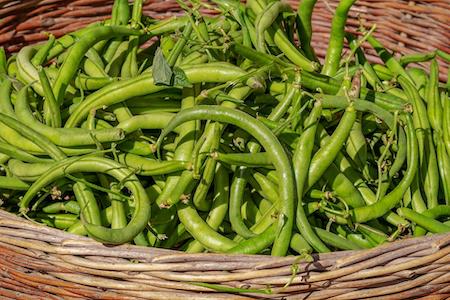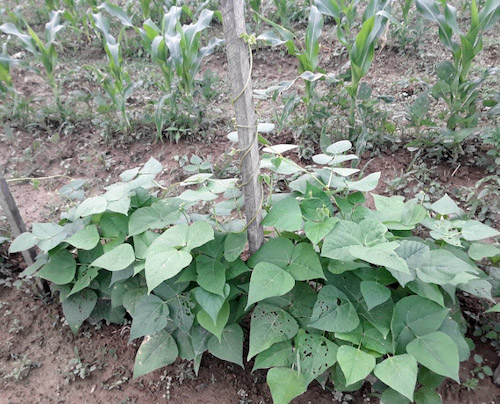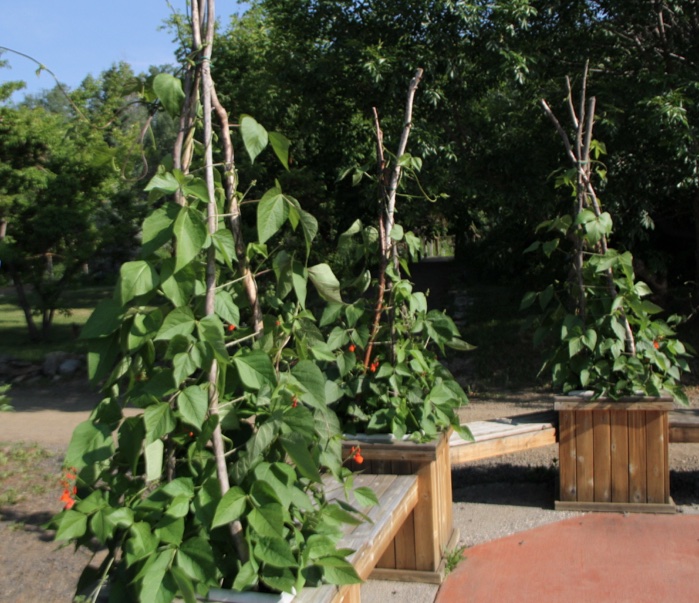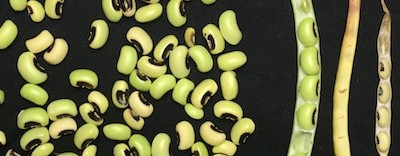Beans — Versatile, Nutritious and Easy to Grow
By Janet Scheren, Fairfax Master Gardener

Green beans
If you ask experienced gardeners what five crops they consider essential to achieve some degree of self-sufficiency, beans always make the list no matter whom you ask. Easy to grow, nutritious and delicious — they are filling and provide a good source of protein and fiber. They are also quite versatile. You can add some form of beans to almost any dish from soups and salads to casseroles and stews or let them stand alone as a vegetable or salad course. An added benefit, these nitrogen-fixing legumes require less fertilization than most crops and actually add some fertility to the soil.
Perhaps best of all, there are so many ways to preserve the bounty of your harvest. You can freeze, pickle, pressure can or dry beans for use throughout the year. Dry beans, if stored in a cool, dry place, can last up to three years. And unlike many other crops, they don’t require any dehydration equipment to produce a ready-to-store product. Leave the pods on the plant and pick dry beans when the pods are dry and the beans inside rattle. In rainy, humid weather you’ll avoid moldy beans by harvesting the pods once they turn yellow and flaccid and bringing them inside to complete drying under cover.
Most of the beans grown in the typical American garden are descendants of those grown by native peoples in the traditional Three Sisters gardens. Many more from the far corners of the world are being incorporated to add interest to the garden and dinner table. These include dragon tongue beans and other long beans.

Bush beans
Types of Beans
Bush beans are upright plants that grow about 2 feet tall (60 cm) and do not need support. They have a shorter period of flowering and pod set, although they may continue to flower and produce pods as long as you harvest them regularly. As with other annual plants, their mission is to reproduce themselves by setting seed, so removing their seed pods keeps production going. Bush beans are particularly good for pressure canning and for freezing, since you can gather a large harvest of beans at one time from a row of plants.
Pole beans are twining vines that grow 6 feet or more and must be supported with a trellis, teepee or other structure. Pole beans can be harvested throughout the summer because they flower and produce new pods all season long. Pole beans are well suited to smaller gardens, growing up rather than out and producing the same amount of beans.
Filet beans are the French haricot vert. These fine delicate beans are available as bush or pole varieties.

Scarlet runner beans
Scarlet runner beans, Phaseolus coccineus, are the beauty queens of the bean world, producing abundant red, pink or bicolor blooms on vines reaching up to 10 feet high (3 m). These beans should be picked when their pods are between 4 and 6 inches long. When young and fresh, you can use these pods like snap beans. After that stage you can shell out the immature seeds or allow them to mature and dry. Dried runner beans can be used like other dried beans.
Half-runner vines can benefit from some support, although they usually do not grow to more than 3 feet tall.
Lima beans, Phaseolus lunatus, grown for their buttery taste. are best grown in warm soils that are somewhat coarser-textured and sandier. They have a somewhat longer growing season than others. They are available as bush or pole beans. For fresh-shelled beans, harvest them when the seed color has changed to cream or white and the beans begin to bulge in pod. Do not eat raw lima beans.
Yard-long beans, Vigna unguiculata, also known as “asparagus beans,” are popular in Asian dishes, due in part because these species require very warm weather to produce pods. Pods can reach more than 10 feet long, depending on the variety; however, most are between 1 and 2 feet (30 to 60 cm). Pick these before the seeds expand and while the pods are still long, tender.

Blackeyed peas
Black-eyed peas and cowpeas, Vigna unguiculata, are the same species as yard-long beans with similar requirements for warm soil and air and are typically bush beans.
The selection of beans available through seed catalogs is much greater than on the shelves in grocery stores, with hundreds of different sizes, colors, markings and uses. Most beans are non-hybrids and all are self-fertile so you can also save dried seed for future planting.
Growing Conditions
Beans grow best in slightly acidic to neutral soil, pH between 6 and 7. So they’re a good fit for most existing gardens. They prefer well draining clay or silty loam soil with lots or organic matter. Beans also benefit from inoculation with the bacteria Rhizobium. These bacteria enhance plant growth and increase bean yield. You can purchase powdered Rhizobium inoculum and treat the seeds before planting. You can also add in some soil from plots where beans have grown successfully in the past.
Pests and Diseases
While beans are fairly easy to grow there are a few pests and diseases to keep an eye out for. Cutworms chew stems at the soil line, leaving the severed tops uneaten. Bean leaf beetles feed on leaves, especially young tender ones, which can kill plants. They can also be infested with stink bugs which sting their buds. If your beans begin to die from the soil up, they may be infected by a root-rotting pathogen. A best practice it to rotate beans around the garden and avoid planting them where other beans and other legumes, such as peas, have grown for four years.
Viruses, spread by insects, can also affect bean production. If you notice a single plant in a row that has unusual leaf coloration or strangely puckered leaves, pull the entire plant and dispose of it. Look for varieties that are disease resistant.
When planting beans space them out and control weeds to ensure good air circulation. This will help avoid various issues such as rust, anthracnose, bacterial leaf spot, powdery mildew and downy mildew.
Resources
• Virginia’s Home Garden Vegetable Planting Guide: Recommended Planting Dates and Amounts to
Plant, Virginia Cooperative Extension, Virginia Tech, Virginia State University
• Home Grown Pantry, by Barbara Pleasant
• Grow Great Virginia Vegetables, by Ira Wallace
• Growing beans in home gardens, Jill Mackenzie, University of Minnesota Extension
• USDA’s Complete Guide to Home Canning, US Department of Agriculture, National Institute of Food
And Agriculture